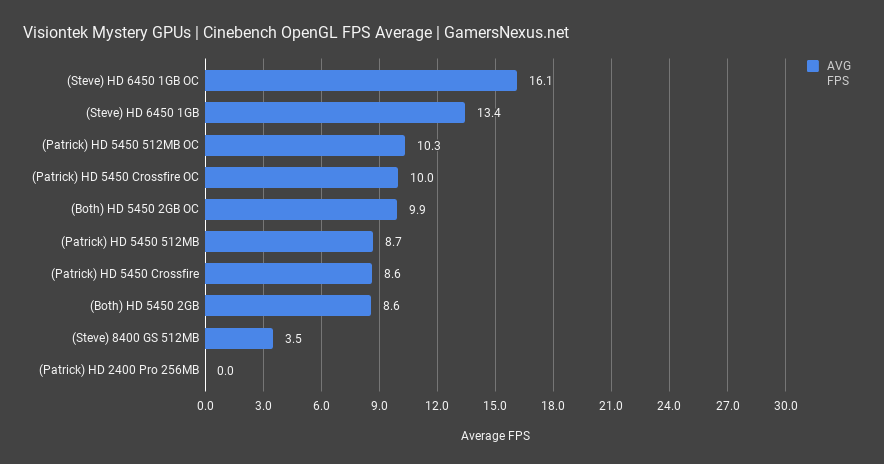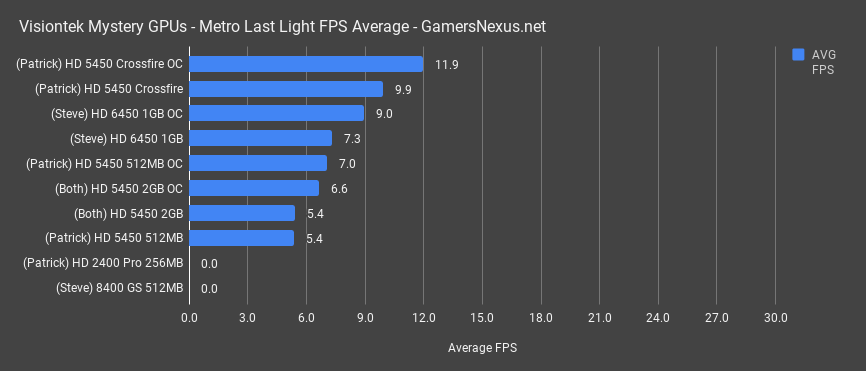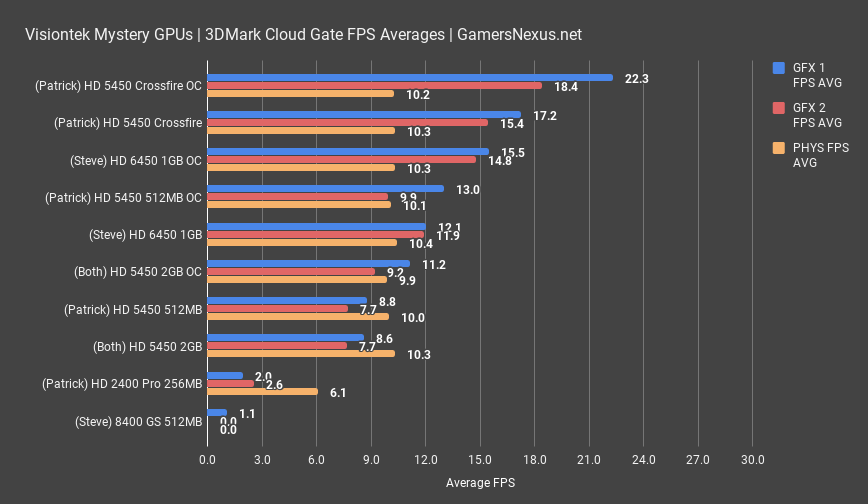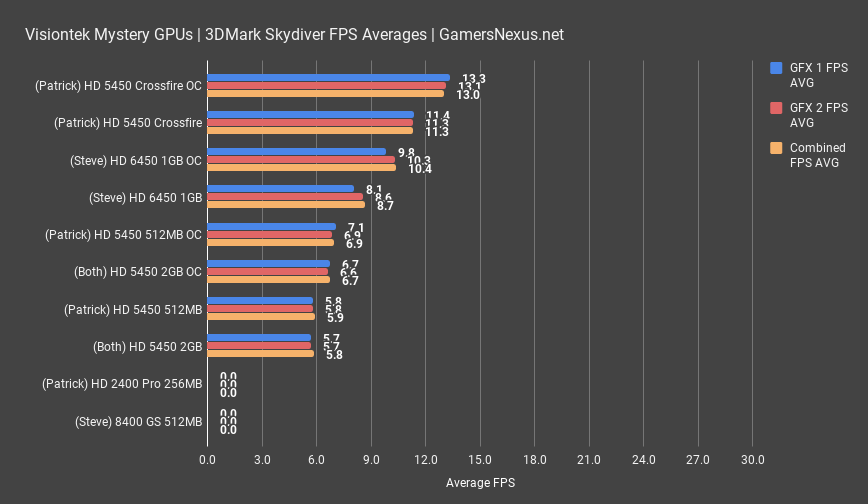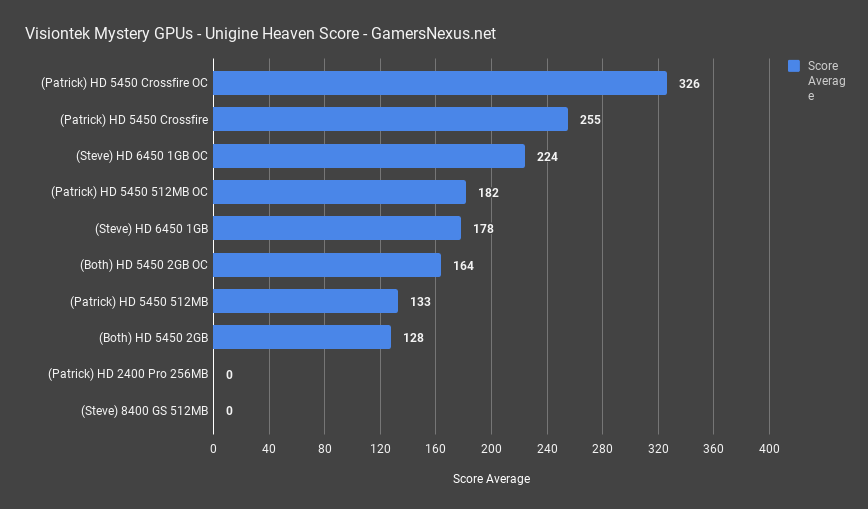GPU manufacturer Visiontek is old enough to have accumulated a warehouse of unsold, refurbished cards. Once in a while, they’ll clear stock by selling them off in cheap mystery boxes. It’s been a long time since we last reported on these boxes, and GPU development has moved forward quite a bit, so we wanted to see what we could get for our money. PCIe cards were $10 for higher-end and $5 for lower, and AGP and PCI cards were both $5. On the off chance that Visiontek would recognize Steve’s name and send him better-than-average cards, we placed two identical orders, one in Steve’s name and one in mine (Patrick). Each order was for one better PCIe card, one worse, one PCI, and one AGP.
The Cards
As mystery refurbs, none of the GPUs were packed in their original boxes, but identifying them was pretty easy, with one exception. Visiontek has worked almost exclusively with ATI/AMD in the recent-ish past, which made one unlabelled PCI GPU with an NVIDIA branded die difficult to look up. None of the numbers etched into the die helped, but after some excessive effort that we’ll go into later, we had our list.
Steve | Patrick | |
PCIe ($10) | Radeon HD 6450 1GB | Radeon HD 5450 2GB |
PCIe ($5) | Radeon HD 5450 2GB | Radeon HD 5450 512MB |
PCI | GeForce 8400 GS 512MB | Radeon HD 2400 Pro 256MB |
AGP | Radeon X1300 | Radeon HD 2600 XT |
It’s safe to say that Visiontek didn’t recognize Steve and try to send him a ringer. They did, however, send me a card for $10 that was exactly the same as a card they sent to Steve for $5. I also got a different (worse) version of the same GPU for my $5 PCIe card.
As readers that skimmed our 2014 article on Visiontek’s mystery boxes may have noticed, these are basically the same cards that were being offered five years ago, except that they cost LESS: $1/$2/$3 for AGP/Radeon 2000-3000/Radeon 4000-5000 respectively. The 8400 GS and the HD 6450 are the only two cards we received that were not offered in those older, cheaper boxes. Moreover, at the time of this writing, all the mystery GPUs have disappeared from Visiontek’s site again. Either we bought them all, or Visiontek is waiting for the HD 5450 market to heat up again.
Happily, the 5450 is a Crossfire capable GPU, so getting two of them meant that I had a chance to compete with Steve’s 6450. Obviously identical cards or at least identical amounts of VRAM would be ideal--and I did experiment with that briefly, using the two 2GB cards together, although it was against the spirit of competition. One of the 2GB 5450s was a terrible overclocker, though, so I continued with the mismatched pair.
Since Steve and I were each sent identical 2GB HD 5450s, the higher overclocking of the two was chosen for testing and those results were used for both of us. We could have scored each card individually, but as the old hardware reviewer saying goes: life is short, don’t spend an hour testing a third decade-old HD 5450 that can’t even overclock as high as the first two. The Crossfire OC used for testing was 700MHz core clock (up from 650MHz) and 725MHz memory (up from 500MHz) on both cards. They could have been tuned individually, but doing them together was easier. Alone, the lower-capacity 512MB 5450 managed a memory clock of 900MHz without visible artifacting. All overclocking was done through AMD’s control panel.
The Plan
Visiontek may not have stacked the deck, but one of us got a better deal. Highly scientific benchmarking was the only way to know for sure which selection of $5 decade-old GPUs was superior. With that in mind, the first step was building a compatible test bench.
Testing PCIe GPUs is something we do constantly. We have shelves full of motherboards with PCIe slots, dating back to the beginnings of GN. We could plug in every PCIe GPU that we’ve ever had and still have slots left over, but PCI and AGP are a different story. The only motherboard with PCI slots that we’ve used in normal benchmarks lately is the ASUS P8Z68-V PRO, the board we use for testing our i5-2500K and i7-2600K. This board wouldn’t POST with a PCI card connected. Neither would the nearly identical P8P67 Deluxe sent in to us by a viewer. It’s probably a solvable problem, but it wasn’t worth spending time to figure it out, so I began trying more boards that were sent to the PO box by viewers.
The EVGA 790I FTW was promising, but damage to the CPU socket meant that it would constantly reset BIOS settings, preventing the selection of a PCI card for primary display. The Gigabyte GA-M750SLI-DS4 is an AM2+ board and therefore needed an old Athlon 64 chip socketed to apply a BIOS update before it would support the Phenom II X6 1090T we preferred for testing, as well as a replacement CMOS battery. It would boot and then crash using a drive with Windows 10 preinstalled, but Windows 10 refused to even attempt a clean install. This led to some increasingly desperate attempts to boot into Windows with the Nvidia card connected long enough to figure out its name, which didn’t work. The system worked fine using Windows 7 until I started swapping GPUs, after which BIOS issues started reappearing. The board also didn’t support Crossfire and could only fit 4GB of DDR2, since we don’t have any sticks larger than 1GB, so it was a wash anyway.
After two or three days of clocking in and not getting anything done, I gave up trying to get creative with old viewer-donated hardware and dug out our ASUS A88X-PRO and an A10-7890K, review samples from the olden days when AMD wanted us to test their APUs. It works, it has PCI slots, it supports Crossfire, it causes no problems with Windows 10. Boring, but usable. The integrated GPU was disabled in all tests.
As for AGP, we didn’t bother. We only have one motherboard with an AGP slot, a broken one donated by a viewer (at least, it was broken by the time we got it). We could have bought a board on ebay to continue testing, but since we’d have to use a different CPU and RAM the results wouldn’t have been comparable, and trying to boot Windows 10 would be optimistic. I’m declaring my HD 2600 XT the winner in the AGP category because its copper cooler is heavier and probably worth a couple cents more as scrap, and it has a cool picture on it.
The Tests
We tried to keep the benchmarks semi-modern while staying within the hardware’s capabilities, but the PCI cards are not DX11 capable and, in fact, had plenty of difficulty just launching Windows 10. We used 3DMark’s Cloud Gate and Sky Diver benchmarks, the Cinebench R15 OpenGL test, Unigine Heaven, and Metro Last Light. Tests were run at 720p because Patrick’s 512MB HD 5450 didn’t like running 1080p Crossfire tests, and he wanted to be able to use the Crossfire advantage because he’s a cheater. Rest assured, the GPUs were still the bottleneck at that resolution. The scores recorded are all the benchmark-provided numbers, which is NOT the method we normally use for scoring games (i.e. Metro Last Light), but it was hard enough getting these tests running at all without adding third-party FPS logging software into the mix.
Cinebench Retro GPU Benchmark
We run the Cinebench OpenGL test for extra verification during CPU testing, although those numbers don’t make it to the published reviews. It’s intended to be a GPU rather than a CPU test, but R15 was released in 2013, and it’d take a pretty low-end GPU these days to bottleneck it. Fortunately, that’s exactly what we have.
The HD 6450, both stock and overclocked, handily tops the chart at 16.1FPS average. This is the only one of our tests that doesn’t utilize Crossfire, so the HD 5450s all scored roughly the same in all configurations, but with slight advantages from overclocking, led by the extra-fast 512MB card. The 8400 GS brought up the rear with an abysmal 3.53FPS average, but at least it actually ran the test, which the HD 2400 Pro did not. Cinebench runs a validation pass before the OpenGL test to make sure everything is working correctly, which the HD 2400 Pro repeatedly failed.
Mystery Box GPU Benchmark: Metro: Last Light
Metro is the only real game on our list, because it’s one of the very few games we’ve tested in recent memory that could potentially run on these cards. The benchmark was run in DX11 at 720p with high quality, which ruled out the older non-DX11-capable cards. We ran the entire benchmark pass and took the provided numbers from the end rather than our usual method of using a frame logging software: after all, when the average framerate is under 10, the 0.1% lows don’t seem quite so important.
At the top of the chart is the pair of overclocked Crossfire 5450s, with an average framerate of 11.9 that might actually become playable with some settings lowered. Impressively, even the stock 5450s in Crossfire beat the single overclocked 6450, although it too gained a good bit of performance from overclocking. The 512MB 5450 runs at an impressive 5.4FPS AVG, which ties with the 2GB HD 5450, illustrating that memory isn’t the limitation here, but rather the core. This is illustrated a second time when our overclocked 5450s effectively achieve the same 7FPS AVG, within overclocking variance between the two. CrossFire scaling versus a single card was an impressive 83% stock-to-stock. It’s rare to find that kind of scaling in modern titles, but still happens sometimes.
Retro GPU Benchmark - Cloud Gate
Cloud Gate is a test meant for low-end systems like laptops, but it works for ancient GPUs as well. The two graphics tests are the relevant ones here, as it would take a really awful GPU to bottleneck the physics test instead of our 7890K. Only the HD 2400 Pro performed that poorly, but this was also the only test that it could complete at all. The 8400 GS consistently crashed after completing the first graphics test at about one frame per second, but it made a valiant effort. In the very least, the card still achieve 60 frames per minute, which sounds impressive if you zone-out and miss the changed metric of time.
On the high end of the chart, the overclocked Crossfire cards dominate again, managing an almost semi-bearable 22.3FPS in the first graphics test and 18.4FPS in the second. The overclocked 6450 scored almost as high as the stock Crossfire 5450s, roughly in line with the scaling seen in the Metro test.
Retro GPU Benchmark - Sky Diver
Sky Diver is a real test, in the sense that it was made with desktops in mind rather than laptops and APUs. There’s also no pure physics test, instead making do with a “combined” test that was absolutely GPU-limited with these cards. The gradient of scores looks a little smoother than in Cloud Strike at a glance, but that’s only because the lowest-end GPUs could actually run Cloud Strike, while Sky Diver is beyond them. And they were removed from the test. CrossFire scaling is again about 2x in this benchmark, with the worst card operating at 5.7FPS AVG and functionally tied, within error margins, to the HD 5450 512MB card. This again illustrates that the extra VRAM capacity really doesn’t help in these benchmarks.
Unigine Heaven
Unigine Heaven is the last of the tests, and it largely confirms what the others already showed. The overclocked Crossfire cards were the best-scoring by far, and the stock 2GB 5450 lags ever-so slightly behind the stock 512MB one. The CrossFire 5450s ended up at 326 points when overclocked, leading stock CrossFire performance by 28%. The stock 5450s in CrossFire led the fastest single-card 5450 stock score of 133 by 92%, posting nearly perfect scaling.
Conclusion: Is the GPU Mystery Box Worth It?
As for who “won,” the HD 5450s that I got regularly topped the charts with crossfire, and the 512MB card turned out to be a better overclocker than either of the two 2GB cards. As for the PCI cards, the 2400 Pro managed to fully complete all three Cloud Gate test segments, while the 8400 GS completed one segment and Cinebench. In terms of raw numbers, then, my group of cards won--but in terms of monetary value and potentially having any use at all, Steve may have won, since we might slap the 6450 into a system just to get a display out someday.
As for whether it was worth the price, the answer is, generally, "no." Even if you just need an extra HDMI port for testing a motherboard, it would be more practical to find a $10 card on Ebay that definitely meets your requirements than buying a mystery box. We had fun with it, but now we have to find someplace to put all of these cards.
Editorial, Testing: Patrick Lathan
Hosts: Steve Burke, Patrick Lathan
Video: Andrew Coleman
